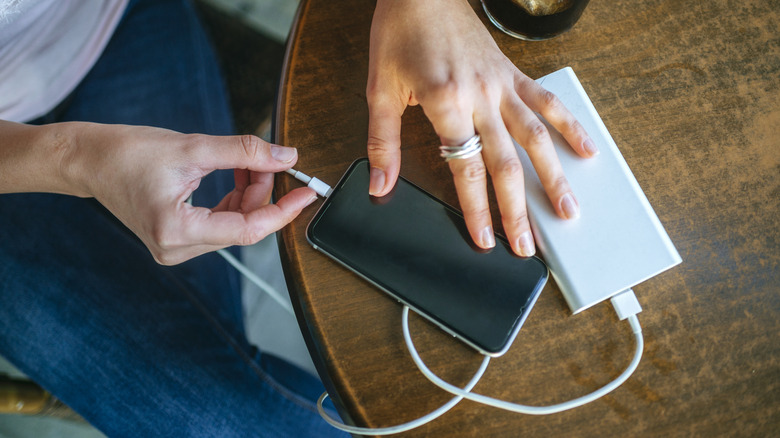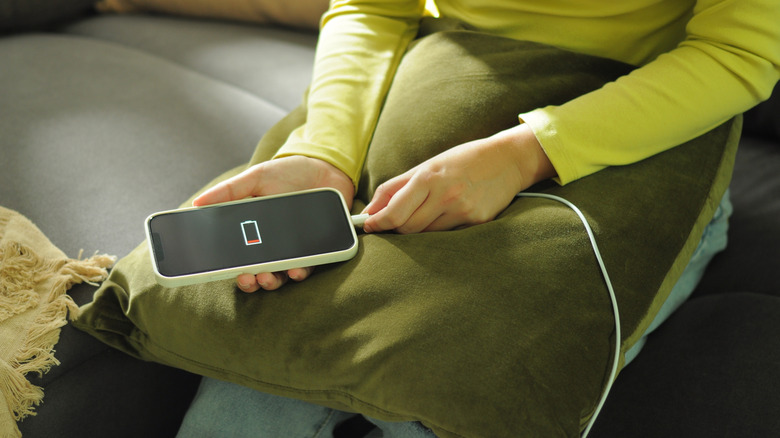A Regular Phone Charger May Be Less Useful In Humid Places. Here's What To Pack Instead
Imagine yourself just landing in Bali or Costa Rica, the humid air hitting you like a warm hug. Later, you try to recharge your phone, but there's a warning message popping up on your screen: "moisture detected." Because of that, your phone refuses to charge. You're wondering what could be wrong, but what you probably don't know is that many modern smartphones — such as the Samsung Galaxy series and the iPhone X series — often come with moisture sensors in their USB-C ports. These sensors are designed to automatically disable wired charging in case of moisture, as this protects against corrosion or short-circuiting. Damp air — and not necessarily actual liquid — is enough to trigger this warning, and it's more likely in tropical or humid regions like southeast Asia, coastal Europe or rainforest retreats.
If your phone is built with this feature, you might get the warning even after a casual day at the pool, a surf session, or a misty jungle hike. And it can ruin your day, as many users have complained on various forums. That's exactly where a wireless charger comes in as an essential travel companion you shouldn't leave behind, especially in wet climates. Since wireless charging wouldn't require the USB port which is the location of the humidity sensor, it easily stands out as the perfect alternative. So if you're planning your hiking or camping adventure to destinations with humid conditions, you should opt for wireless charging as your phone's lifeline.
Why humidity prevents your phone from charging
It goes without saying that water and electricity don't combine well — and, certainly, manufacturers know this too. Water can cause electrical problems or, worse off, permanent damage to your phone. Even if your phone is water-resistant, the sensor will still not allow charging as long as it senses that the charging port is wet or there's an unsafe level of humidity. In a report via TheSun, Samsung was quoted explaining that "If there is water in your device's USB port or moisture is detected that exceeds a set point, charging will not be supported." According to the report, this serves as "a safety measure to protect your phone from damage and corrosion."
A Reddit user by the name UndeadCaesar recounted how their phone suddenly displayed the "moisture detected" message even when the phone wasn't exposed to water. "It showed for the first time when I was sitting on an airplane just holding my phone," the user explained. In this user's case, the humidity level within the airplane cabin must have triggered the moisture detection sensor, since the sensor is generally sensitive to any moisture or condensation. Even though the phone may seem dry to the touch, this might not be so for the internal sensor. While there are several solutions across the internet — such as turning off the phone, allowing the port to dry, and wiping — they're time-consuming, sometimes up to 5 hours, and may not always work as you want. But this is not to say you shouldn't try those steps; you should, especially if the phone has truly been exposed to wet conditions. Still, if you need to charge and use your phone urgently, going wireless is the ultimate solution.
Wireless charging as a lifesaver in humid conditions
If you're planning for humid weather, it's highly advisable to pack a portable wireless charging pad as part of your travel kit. Foldable or magnetic versions can easily fit into your carry-on. But confirm that your phone supports Qi wireless charging (through the phone specifications or the manufacturer's information). At your accommodation or any other place where you need to charge your phone, simply position your wireless charger on a flat surface such as a desk, then place your phone on top of it, and voilà: you've overcome the sensor-induced cable frustration.
A quick heads up though: you should note that airline regulations differ for power banks and wireless chargers. Be sure that your charger doesn't have a built-in battery: Power banks may not comply with lithium restrictions based on battery size, as a capacity beyond 160Wh may not be allowed. So be sure to check your airline's rules and check TSA carry-on luggage regulations before getting to the airport. However, as long as your wireless pad has no internal battery, you're good to go. Always remember: saving yourself so much stress is just a matter of knowing the right charger to have with you. Go wireless or find yourself enmeshed in frustration when your phone's humidity sensor goes haywire.


